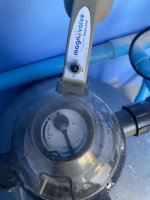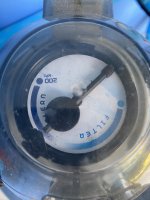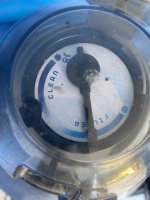Last edited by a moderator:
Suddenly my pool is not clear
- Thread starter corrado95
- Start date
You are using an out of date browser. It may not display this or other websites correctly.
You should upgrade or use an alternative browser.
You should upgrade or use an alternative browser.
I think I understand that a CYA at 70 is good for 2 things. It will save my cell and it will save salt as chlorine value will go down slower. I will take care of that but as I understand that have nothing to do with my cloudy water. As I wrote earlier today I have cleaned my pool and filter today. But is my cloudiness a mysterium for you all too?
- Jun 22, 2014
- 52,053
- Pool Size
- 17888
- Surface
- Fiberglass
- Chlorine
- Salt Water Generator
- SWG Type
- CircuPool RJ-45 Plus
There are two types of acid we use in pools:What kind of acid do I have
1 - Cyanuric Acid - Used to increase the CYA which protects FC from the sun
2 - Muriatic Acid which is used to lower pH. It can also lower the TA.
- Jun 22, 2014
- 52,053
- Pool Size
- 17888
- Surface
- Fiberglass
- Chlorine
- Salt Water Generator
- SWG Type
- CircuPool RJ-45 Plus
The higher CYA will help to make free chlorine production more efficient, but it does nothing for salt. Once added to the water, the salt doesn't go away unless you exchange water, have a leak, or over time with lots of swimmers splashing out water.I think I understand that a CYA at 70 is good for 2 things. It will save my cell and it will save salt as chlorine value will go down slower.
For now, yes. That's what we are attempting to help with. By passing the OCLT you helped to rule out algae (for now), so that seem to indicate the cloudiness might be related to your filtration. I suspect that is why Allen has been asking some specific questions about your filter, the gauge, etc. As noted earlier, we aren't big fans of the Zeolite media, but some pool owners like to use it. Sand is generally the preferred media and has been reliable for decades. It can also be "deep cleaned" which help to ensure the filter media does not become compacted or develop "channels" or grooves in the sand which can effect how well it filters.But is my cloudiness a mysterium for you all too?
I read this on a swedish pool page, I have translated it to english. Is it correct or do you have anny correction?There are two types of acid we use in pools:
1 - Cyanuric Acid - Used to increase the CYA which protects FC from the sun
2 - Muriatic Acid which is used to lower pH. It can also lower the TA.
CYANURIC ACID PROTECTS CHLORINE
Stabilized chlorine
Cyanuric acid is a substance that protects chlorine from being broken down quickly by the sun's UV rays. The disadvantage is that it also makes the chlorine more ineffective and that it is not possible to reduce the level to a high level without draining the water and replacing it with new water.
Cyanuric acid is included as a necessary substance in what is known as stabilized chlorine, i.e. Long-acting chlorine and Multichlor (Trichloroisocyanuric acid) as well as Quick Chlorine (Dichloroisocyanuric acid), so when you use these types of chlorine, the cyanuric acid content will build up successively.
By backwashing and refilling with new water, it takes longer before the level becomes too high, Folkpool recommends that you drain at least half the volume at 40 ppm. At the very latest when you reach 50 ppm if you dose chlorine tablets manually.
Chlorine lock?
People sometimes talk about chlorine lock when the cyanuric acid content is too high, sometimes indicated at over 100 ppm, but that is a bit wrong, the cyanuric acid reduces the effect successively and at least 7.5% free chlorine per 100 ppm cyanuric acid is required for the chlorine to be effective.
This means that at 40 ppm cyanuric acid at least 3 ppm free chlorine is required to be effective and at 50 ppm at least 3.75 ppm free chlorine.
Chlorine balance?
Cyanuric acid can also be bought as a separate product and is called Klorbalans at Folkpool and otherwise it is called a stabilizer. It should be used with caution and is rarely necessary.
If you use Long-acting chlorine, Multichlorine or Quickchlorine, you should not add Chlorine Balance separately. If you have automatic dosing or a salt chlorinator with or without automatic control, we want to keep about 1 ppm free chlorine. Then you can see that cyanuric acid can protect the chlorine from being broken down too quickly by the sun.
If you think you want to try this, you should have a cyanuric acid level of a maximum of 20 ppm. For hall chlorinators without control, ensure that it produces during the night and measure the free chlorine content in the morning, aim for approx. 1 ppm free chlorine and accept that the chlorine content drops temporarily to zero in the afternoon after sun and a lot of bathing.
- Jun 22, 2014
- 52,053
- Pool Size
- 17888
- Surface
- Fiberglass
- Chlorine
- Salt Water Generator
- SWG Type
- CircuPool RJ-45 Plus
That statement is false. What they should've said is that the higher the CYA, the FC level must also increase. See our FC/CYA Levels to see the FC-to-CYA relationship.The disadvantage is that it also makes the chlorine more ineffective
Chlorine Lock is a misleading (pool store) term we don't use here at TFP. It basically means the CYA was allowed to go way too high (usually over 100) and then the FC level cannot be increased enough to keep up. This is common for people who rely on chlorine tablets on a regular basis.
Totally false statement regarding stabilizer. It IS necessary, not only to protect free chlorine from the sun (especially in salt pool), but also protects the swimmers from the potentially harsh effects of chlorine.It should be used with caution and is rarely necessary.
I must emphasize, you will become frustrated if you bounce all over the internet to try and compare pool care instructions. Here at TFP we have years of science and owner-user backed proof of reliable pool water care for both water clarity and sanitation. Everything you need to know is packaged-up in one location - Pool Care Basics. That page will explain everything for you.
The chart used by TFP is similar to this statement, however it (FC/CYA Levels) shows that 7.5% is the absolute minimum FC to have. The actual target range is higher.the cyanuric acid reduces the effect successively and at least 7.5% free chlorine per 100 ppm cyanuric acid is required for the chlorine to be effective.
We have seen many instances on the forum where people have hovered around the minimum and get algae. This is because the actual FC dips below the minimum due to bather load or extreme heat, etc. So the target range is higher to account for all the variables that may occur throughout the day in the use of the pool. It is also recommended to test daily when the pool is being used a lot and the temperatures are high. This is the only way to ensure your FC level is being maintained at the proper level to sanitize the pool.
With regards to cloudiness. Now that you have cleaned your filter. Give it 48 hours to circulate and ensure your FC level is at the proper level per the FC/CYA Levels for your current level of CYA. If you add CYA, then adjust your FC levels to maintain proper sanitization.
The only reason I can think of for this problem is that the cloudyness come from filter media. Is it possible that someting could happen to the filter valve? The brand of the filter is Poolrite/Magnapool. Can you tell me what I should look for. I understand that there are lots of pool ecperts at TFP and that is the only possible cause that have come up. The value of CYA has nothing to do with this problem
- Jun 22, 2014
- 52,053
- Pool Size
- 17888
- Surface
- Fiberglass
- Chlorine
- Salt Water Generator
- SWG Type
- CircuPool RJ-45 Plus
A filter valve (multiport valve) would not cause cloudiness. Cloudiness can either be from:
- Bad pool filter media; or requires cleaning
- A large addition of certain chemicals at one time like calcium
- Algae. Did you get a chance to do the Overnight Chlorine Loss Test?
- Bad pool filter media; or requires cleaning
- A large addition of certain chemicals at one time like calcium
- Algae. Did you get a chance to do the Overnight Chlorine Loss Test?
How about your memory? You wrote this to me: "Losing only 0.5 ppm of free chlorine is good. You passed the OCLT. "A filter valve (multiport valve) would not cause cloudiness. Cloudiness can either be from:
- Bad pool filter media; or requires cleaning
- A large addition of certain chemicals at one time like calcium
- Algae. Did you get a chance to do the Overnight Chlorine Loss Test?
You say "bad filter media". How can it be bad? Media was changed 2 years ago (zelbrite) What I think is that the media has come out in the pool, but how can that happen? If the valve brokes in some way, is it possible that the filter media can come out in the pool? The problem started about 10 days after I made the cleaning of the pool and cleaning of filter. I had not put anything into the pool.
I tried to catch what is making the cloudiness by walking back and forth in the pool during 2-3 minutes. In my hand, low in the water i held a cone of cloth used in the kitchen. later when it dried i could see that there where many small particles. The only thing I can think of is the filter media.
Or could it come with the water from our well? I have asked other pool owners in our area and the had no problem with cloudiness. I have also one filter taking care of the incoming water and that filter has some kind of small "pearls" in different sizes as filter media.
- Jun 22, 2014
- 52,053
- Pool Size
- 17888
- Surface
- Fiberglass
- Chlorine
- Salt Water Generator
- SWG Type
- CircuPool RJ-45 Plus
Yeah, okay. You passed the OCLT, so we'll put algae on the back burner for now. A lot can happen to filter media in two years. The multiport valve won't be a factor in cloudiness, but there is a concern for a damaged lateral. If we continue to rule out algae or chemistry via the OCLT, then you might need to open that filter and examine the filter media, laterals, and center standpipe for damage. The tiniest compromise in a lateral of center pipe will allow media to get through.How about your memory?
- Jun 24, 2021
- 16,366
- Pool Size
- 29000
- Surface
- Vinyl
- Chlorine
- Salt Water Generator
- SWG Type
- CircuPool RJ-60 Plus
For clarity, you only lose salt in a pool by splashout, draining to waste, or backwashing, or any other method that takes water out. Evaporation leaves the salt in the pool. The chlorinator does not "use up" the salt. After the chlorine does its job, it goes back to being salt in the pool.I think I understand that a CYA at 70 is good for 2 things. It will save my cell and it will save salt as chlorine value will go down slower
@Texas Splash in looking at his pictures of the pool that he posted it has a bit of a greyish/greenish cast. He is using a pool filter with Zelbrite. I use the same media. It is possible that he cracked, or didn't install the laterals correctly, causing the zelbrite to be returned to the pool. As the cloudiness happened when he did the filter clean, I would suspect this is possible. Zelbrite can be very fine.A filter valve (multiport valve) would not cause cloudiness. Cloudiness can either be from:
- Bad pool filter media; or requires cleaning
- A large addition of certain chemicals at one time like calcium
- Algae. Did you get a chance to do the Overnight Chlorine Loss Test?
Last edited:
When chlorinator making chlorine out of the salt, do you say that this will no reduce the amount of salt?For clarity, you only lose salt in a pool by splashout, draining to waste, or backwashing, or any other method that takes water out. Evaporation leaves the salt in the pool. The chlorinator does not use up the salt. After the chlorine does its job, it goes back to being salt in the pool.
@Texas Splash in looking at his pictures of the pool that he posted it has a bit of a greyish/greenish cast. He is using a pool filter with Zelbrite. I use the same media. It is possible that he cracked, or didn't install the laterals correctly, causing the zelbrite to be returned to the pool. As the cloudiness happened when he did the filter clean, I would suspect this is possible. Zelbrite can be very fine.
- Jun 24, 2021
- 16,366
- Pool Size
- 29000
- Surface
- Vinyl
- Chlorine
- Salt Water Generator
- SWG Type
- CircuPool RJ-60 Plus
Yes. After doing its job sanitizing the pool it will return to salt in the pool. The only way to reduce salt in a pool is to remove water (draining, splashout, backwash, drain to waste), NOT through evaporation.When chlorinator making chlorine out of the salt, do you say that this will no reduce the amount of salt?
Correct, it will not loose salt in the chlorinating process. The salt can only be diminished if you have a leak, backwash, kids splash out. Evaporation only loses the water but the salt remains in the water.When chlorinator making chlorine out of the salt, do you say that this will no reduce the amount of salt?
- Mar 5, 2020
- 3,221
- Pool Size
- 66000
- Surface
- Plaster
- Chlorine
- Salt Water Generator
- SWG Type
- Astral Viron V35
When chlorinator making chlorine out of the salt, do you say that this will no reduce the amount of salt?
The part of salt (NaCl) that we are interested in, and that actually is what the salt drop test is testing, is chloride (Cl-). Simplified speaking, the chlorinator just strips off an electron each from two Cl- ions and turns them into chlorine gas (Cl2). When this chlorine gas dissolves into the water, one of the two Cl becomes Hypochlorous Acid (HOCl), which is the actual sanitizer in the pool (and part of what shows as "Free Chlorine" (FC) in the chlorine drop test). The second Cl grabs a fresh electron and turns straight back into chloride (Cl-). Once the HOCl has killed a germ or oxidised something, the first Cl also turns back into Cl-.
It's a cycle, chloride gets turned into chlorine gets turned into chloride gets turned into chlorine, ...
Thanks for a great explanation!The part of salt (NaCl) that we are interested in, and that actually is what the salt drop test is testing, is chloride (Cl-). Simplified speaking, the chlorinator just strips off an electron each from two Cl- ions and turns them into chlorine gas (Cl2). When this chlorine gas dissolves into the water, one of the two Cl becomes Hypochlorous Acid (HOCl), which is the actual sanitizer in the pool (and part of what shows as "Free Chlorine" (FC) in the chlorine drop test). The second Cl grabs a fresh electron and turns straight back into chloride (Cl-). Once the HOCl has killed a germ or oxidised something, the first Cl also turns back into Cl-.
It's a cycle, chloride gets turned into chlorine gets turned into chloride gets turned into chlorine, ...
Thread Status
Hello , This thread has been inactive for over 60 days. New postings here are unlikely to be seen or responded to by other members. For better visibility, consider Starting A New Thread.




